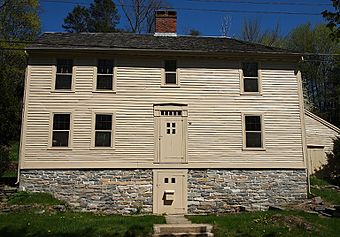Dr. Joshua Lathrop House facts for kids
|
Dr. Joshua Lathrop House
|
|
|
U.S. Historic district
Contributing property |
|
 |
|
| Location | 377 Washington Street, Norwich, Connecticut |
|---|---|
| Area | 2 acres (0.81 ha) |
| Built | 1750 |
| Architectural style | Colonial, Georgian, Saltbox |
| Part of | Norwichtown Historic District (ID730019751) |
| NRHP reference No. | 70000727 |
Quick facts for kids Significant dates |
|
| Added to NRHP | December 29, 1970 |
| Designated CP | January 17, 1973 |
The Dr. Joshua Lathrop House is a very old and special house located at 377 Washington Street in Norwich, Connecticut. Built around 1750, it's a great example of old-style American homes. This house is famous because it was once the home and workplace of Dr. Joshua Lathrop, who was the very first pharmacist (someone who prepares and sells medicines) in Connecticut. Because of its history and unique style, the house was added to the National Register of Historic Places on December 29, 1970. It's also part of the historic Norwichtown Historic District.
Contents
About the Dr. Joshua Lathrop House
The Dr. Joshua Lathrop House is found in a historic part of Norwich called Norwichtown. It sits on the east side of Washington Street. The house has two main parts. One part is an older style known as a saltbox house. The front part is a more common Georgian style.
What Does It Look Like?
The front of the house has a sloped roof and a chimney in the middle. It has 2-1/2 stories. The house is built on a hill. This means the front basement level is fully visible. Today, the main entrance is through a door in the basement wall. The original entrance was above this.
The front of the house has four window sections. They are placed a bit unevenly. The main door is in the center. There are two windows to its left and one to its right. The back part of the house, called the "leanto" section, also has two stories. Its windows and doors are also placed unevenly.
Inside the House
When you go inside, you can see many original features. These include old wooden panels on the walls. There are also fireplaces that have been there for a very long time. These features help us imagine what life was like hundreds of years ago.
History of the Lathrop House
This house was built around 1750. It was built by Joshua Lathrop himself. He ran a drugstore from this very house. He worked with his brother, Daniel. Their drugstore is thought to be the first of its kind in the Connecticut Colony.
Joshua Lathrop's Pharmacy
Joshua Lathrop worked with his brother until 1774. After that, he partnered with his nephews and his own son. He continued to work as a pharmacist until he passed away in 1807. This house was not just his home, but also an important business place. It helped people get the medicines they needed in colonial times.
A Famous Visitor?
The house has another interesting historical connection. There is a possibility that Benedict Arnold might have lived here. This would have been during the time he was learning his trade with the Lathrop family. This adds another layer of history to this special old house.



